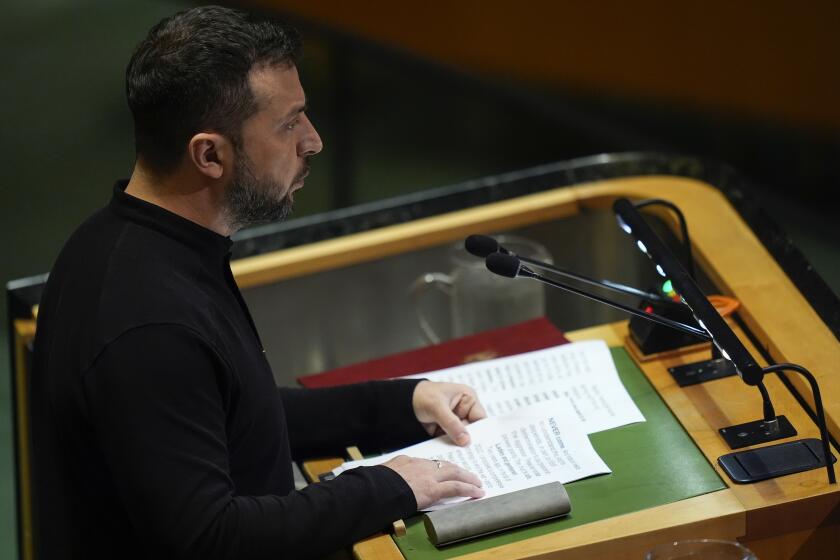Players at Indian Slots Have No Clue on Payout
For California’s casino customers, it’s the real wild card -- a secret that the Native American gambling industry holds close to the vest.
The mystery concerns the payout rates for slot machines: How much of the money pumped into the thousands of chirping contraptions -- the life’s blood of the state’s 50 Indian casinos -- is returned to players as winnings?
Casino executives have the answer, but they tend to guard it like the house vault. State regulators are clueless. And the players can only guess.
“I expect the rates are worse than they are in Las Vegas,” said Bruce Burton, 31, a Murrieta salesman who was heading out of the Pechanga Casino near Temecula, lighter in the pockets than when he arrived. “If the rates were good, the casinos would publicize them.”
California is by far the biggest gambling state that does not require casinos to disclose payouts for one-armed bandits, video poker and other computerized games. The devices bring in more than 80% of the Indian casinos’ $5 billion in estimated annual revenues -- a tally that’s second nationwide to Nevada’s $9.5 billion.
No government agency has suggested that the Golden State’s gambling parlors are fleecing players, and the tribes say that their machines pay on par with the rates in Nevada. But most casino operators decline to provide specific figures. To do so, they say, would tip their hand to competitors.
“I would never release that information,” said Jerry Turk, general manager of the Pala Casino in northern San Diego County.
Divulging payouts doesn’t seem to be a competitive problem in other states with billion-dollar casino markets.
From Nevada to New Jersey and Illinois to Mississippi, non-Indian gambling halls must report their percentages to state authorities. Connecticut is the only top gambling state that requires tribes to reveal their rates.
States with reporting regulations make the numbers public, either by region -- the Las Vegas Strip, for example -- or by individual casinos. The rates, determined by computer chips embedded in the machines, generally range from about 92% in Atlantic City and Connecticut to a tad shy of 95% in Nevada. Most states also set payout minimums -- typically 75% or 80%. California’s is 75%.
The percentages can be deceiving. A 92% rate means that a machine is programmed to pay back, over time, 92 cents for every dollar wagered. The casino’s ultimate take, however, is often greater because so many players feed their winnings back into the machines, bet after losing bet -- the “grind,” in casino parlance.
Eventually, 92% of a dollar becomes 92% of 92 cents, then 92% of 83 cents, and so on, until the player’s last nickel is gone.
Cindy Smith, 45, knows how that goes. The Sherman Oaks saleswoman was spending a recent Friday night at the Pechanga Casino, where she had just dropped $40 at a 25-cent machine. “The odds here probably aren’t that great,” Smith said, looking across the wall-to-wall rows of slots, whose carnival lights colored the faces of glassy-eyed players. “And since they don’t have to report them, they won’t. They probably figure what you don’t know won’t hurt you.”
Smith’s friend, Sylvia Browne, nodded. “This is leisure time for most people, and whether they win or lose isn’t important,” said Browne, an entertainment promoter visiting from Massachusetts. “But I want to know what the return is before I put my dollar in the machine.”
Pechanga executives did not respond to interview requests.
One reason payout rates are kept under wraps in California is that state officials, starting with Gov. Gray Davis, did not insist on a disclosure requirement when they negotiated gambling compacts with the tribes. The 3-year-old compacts spell out the terms for casino regulation.
Critics Angry at Davis
Gambling opponents are still angry that the agreements failed to address payouts. They say Davis stacked the deck for the tribes because they lavished money on his election campaigns.
“He did it as a campaign promise to the tribes,” said Cheryl Schmit, director of Stand Up for California, an anti-gambling group. “From a consumer point of view, this is not a good deal. People need to know what the rates are.”
Davis spokeswoman Hilary McLean denied that campaign cash influenced the governor. She said the tribes held a strong position in the compact talks because California voters had approved an Indian gambling initiative, although the state Supreme Court ruled it unconstitutional.
The state sought the compacts to keep another tribe-backed measure off the ballot, a proposal that would have shielded even more information from the public, McLean said. “Anyone who says the governor went easy on the tribes is laughable,” she said.
McLean and other officials said the payout issue might be on the table when the state reopens negotiations with the tribes in the spring. The discussions are expected to focus on Davis’ bid to collect $1.5 billion a year in revenues from the gambling operations, and the casinos’ proposal to lift the compact limit of 2,000 slots per tribe. If payouts become a topic, the casinos are likely to resist a reporting requirement on grounds that it would infringe on Indian sovereignty, tribal representatives say.
“A problem is trying to get the public to understand everything is based on the tribal government relationship with the state,” said Jacob Coin, executive director of the California Indian Nations Gaming Assn.
Sovereignty Invoked
Over the years, the tribes have repeatedly invoked their sovereignty in fending off state scrutiny of their gambling enterprises. Connecticut, the notable exception, insisted on payout disclosure when it granted tribes the exclusive right to operate gambling machines in the state. California’s casinos enjoy a similar monopoly.
In every state, the federal government is the ultimate authority over tribal gambling. The National Indian Gaming Commission can fully examine the casinos’ financial records, and its auditors check gambling machines to ensure they haven’t been tampered with. But the commission does not require the tribes to disclose their payouts.
“No one has asked us to,” said Richard Schiff, the commission’s chief of staff. “It’s a consumer information item, and we haven’t gotten into that business.”
The commission would be sorely pressed to enforce a payout standard. It has 63 workers to monitor the nation’s 310 Indian casinos. Only three of its field investigators are stationed in California.
Under the compacts, the state has some access to the casinos’ finances.
Howard Dickstein, an attorney who represents five tribes, said state regulators could glean payout rates from documents already available to them. “But they can’t disclose them,” Dickstein said, citing the tribes’ sovereignty.
Eventually, he said, the tribes might agree to a reporting requirement.
“This is all part of a process for the tribes,” Dickstein said. “There is a history of concern and a lack of confidence” in the government. “As time goes on, things will change.”
Players Left to Wonder
Until then, players such as Celia Cardenas will be left to wonder. On a recent afternoon, she moved from machine to machine at the Soboba Casino in San Jacinto, her losses mounting by the minute. The casino does not publicize its payouts.
“If odds were good, they’d post them, right?” said Cardenas, who noted that Las Vegas casinos often advertise the payouts of the “loosest” machines. The 34-year-old store worker from Santa Ana was down $60, which experts say is the average daily loss for California casino patrons.
Cardenas said she had noticed that more people seemed to be hitting jackpots since other casinos opened or expanded in the area. That makes sense to industry watchers such as William Thompson, a public administration professor at the University of Nevada, Las Vegas.
“If there’s just one casino serving a big area, the payouts will be lower -- below 90%, maybe 80%,” said Thompson, who has studied gambling since 1980. “If there’s competition nearby, the rates go up.”
Thompson said his research indicates that the payouts are lower in California than in Nevada. But he can’t be certain.
“Whatever you say they are in California, there’s no way to prove it,” he said.
More to Read
Sign up for Essential California
The most important California stories and recommendations in your inbox every morning.
You may occasionally receive promotional content from the Los Angeles Times.











